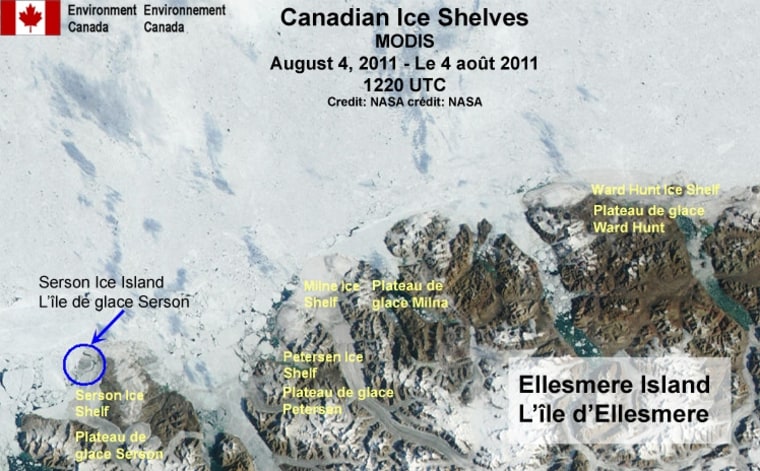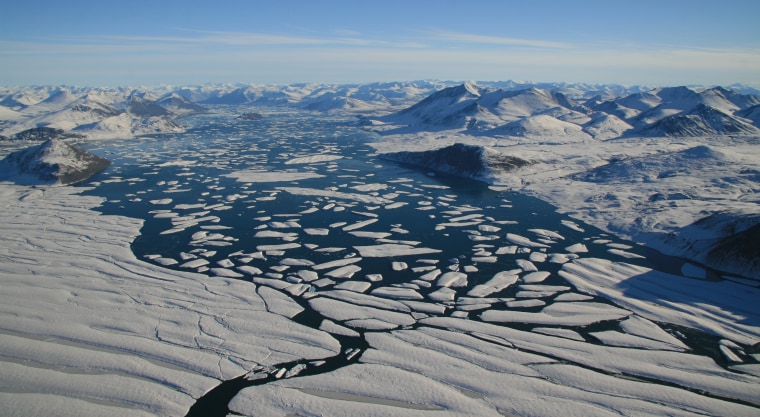Canada in just six years has lost nearly 50 percent of the massive ice shelf area that holds back glacial ice from melting into the ocean, scientists report.
Two of Canada's biggest ice shelves diminished significantly this summer, one nearly disappearing altogether. The two are among six that make up Canada's biggest shelves, all located on Ellesmere Island.
The loss is important as a marker of global warming, returning the Canadian Arctic to conditions that date back thousands of years, scientists say.
Floating icebergs that have broken free as a result pose a risk to offshore oil facilities and potentially to shipping lanes. The breaking apart of the ice shelves also reduces the environment that supports microbial life and changes the look of Canada's coastline.
Luke Copland, an associate geography professor at the University of Ottawa, said the Serson Ice Shelf shrank from 79 square miles to two remnant sections three years ago, and was further diminished this past summer.
Serson went from a 16-square-mile floating glacier tongue to 10 square miles, and the second section from 13 square miles to 2 square miles.
In addition, Ward Hunt Ice Shelf's central area disintegrated into drifting ice masses last summer, leaving two separate ice shelves measuring 88 and 29 square miles respectively, reduced from 132 square miles the previous year.
"It has dramatically broken apart in two separate areas and there's nothing in between now but water," said Copland.
Copland said those two losses are significant, especially since the Ward Hunt Ice Shelf has always been the biggest, the farthest north and the one scientists thought might have been the most stable.
"Since the end of July, pieces equaling one and a half times the size of Manhattan Island have broken off," Copland said in a statement. Copland uses satellite imagery and has conducted field work in the Arctic every May for the past five years.
Co-researcher Derek Mueller, an assistant professor at Carleton University, said the loss this past summer equals up to three billion tons of ice.
"This is our coastline changing," Mueller stated. "These unique and massive geographical features that we consider to be part of the map of Canada are disappearing and they won’t come back."
"Recent (ice shelf) loss has been very rapid, and goes hand-in-hand with the rapid sea ice decline we have seen in this decade and the increasing warmth and extensive melt in the Arctic regions," said Ted Scambos, lead scientist at the National Snow and Ice Data Center at the University of Colorado, remarking on the research.
Copland said their findings have not yet been peer reviewed since the research is new, but a number of scientists contacted by The Associated Press reviewed the findings, agreeing the loss in volume of ice shelves is significant.
Scambos said the loss of the Arctic shelves is significant because they are old and their rapid loss underscores the severity of the warming trend scientists see now relative to past fluctuations such as the Medieval Warm Period.
Ice shelves are much thicker than sea ice, which is typically less than a few feet thick and survives up to several years.

Canada has the most extensive ice shelves in the Arctic along the northern coast of Ellesmere Island. They thickened over time via snow and sea ice accumulation, along with glacier inflow in certain places.
The northern coast of Ellesmere Island contains the last remaining ice shelves in Canada, with an estimated area of 217 square miles, said Mueller, down from 402 square miles six years ago.
Between 1906 and 1982, there has been a 90 percent reduction in the areal extent of ice shelves along the entire coastline, according to data published by W.F. Vincent at Quebec's Laval University. The former extensive "Ellesmere Island Ice Sheet" was reduced to six smaller, separate ice shelves: Serson, Petersen, Milne, Ayles, Ward Hunt and Markham.
In 2005, the Ayles Ice Shelf whittled almost completely away, as did the Markham Ice Shelf in 2008 and the Serson this year.
"The impact is significant and yet only a piece of the ongoing and accelerating response to warming of the Arctic," said Robert Bindschadler, emeritus scientist at the Hydrospheric and Biospheric Sciences Laboratory at the NASA Goddard Space Flight Center in Maryland.
Bindschadler said the loss is an indication of another threshold being passed, as well as the likely acceleration of buttressed glaciers able to flow faster into the ocean, which accelerates their contribution to global sea level.
Copland said mean winter temperatures have risen by about 1.8 degrees Fahrenheit per decade for the past five to six decades on northern Ellesmere Island.
